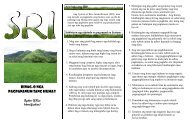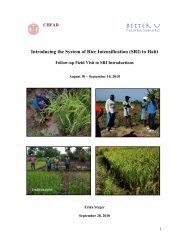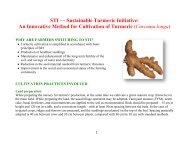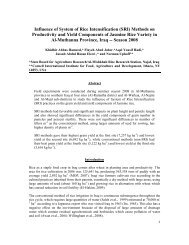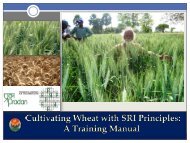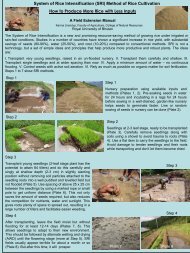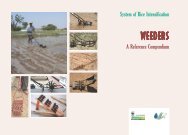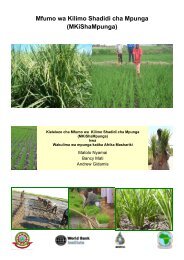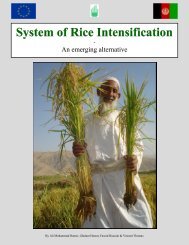EFFECT OF THE SYSTEM OF RICE INTENSIFICATION (SRI) ON ...
EFFECT OF THE SYSTEM OF RICE INTENSIFICATION (SRI) ON ...
EFFECT OF THE SYSTEM OF RICE INTENSIFICATION (SRI) ON ...
Create successful ePaper yourself
Turn your PDF publications into a flip-book with our unique Google optimized e-Paper software.
The degree of GHGs emissions will to a large extend depend on what type of rice cropping systems<br />
is used. Irrigated/continuously flooded systems will pose the largest risks. Flooded rice fields with<br />
anaerobic conditions will produce methane from decomposition of organic matter anaerobically<br />
(Wassmann et al., 2000) and emit CH4 through rice plants (roots and stems) as either diffusion or<br />
ebullition (Neue, 1993). Methane is found in smaller amounts in the atmosphere than CO2 but one<br />
molecule of methane will trap as much heat as 30 molecules of CO2 (Neue, 1993), although Yue et<br />
al. (2005) state that the Global Warming Potential (GWP 3 ) of CH4 is 23.<br />
Nitrous oxide (N2O) is emitted when N is added to agricultural soils, in forms of e.g. fertilizers,<br />
through volatilization of e.g. NH3, leaching, run-off and redeposition (Zou et al., 2009) and though<br />
it is found in smaller concentrations than CO2 in the atmosphere the GWP of N2O is 296 times those<br />
of CO2 (Li et al., 2009). N2O in soils is derived from production of nitrification and denitrification<br />
processes (Zou et al., 2005) and is favored by aerobic conditions. CO2 derived from soil is produced<br />
from respiration from microbes, roots and from bulk soil respectively (Xu et al., 2008).<br />
3.2 The effect of organic amendments and chemical fertilizers on GHG<br />
emissions<br />
Organic amendments or chemical fertilizers will pose various and different affects on GHGs<br />
emissions from soils. Lou et al., (2007) conducted studies on CO2 and N2O emissions from irrigated<br />
rice fields and concluded that when rice straw was applied and incorporated in the soils the<br />
emissions of CO2 and N2O were much higher than fields where straw had been removed and only<br />
rice roots were left. This is because straw contains more cellulose than roots and roots contain more<br />
lignin than straw and will therefore decompose slower than straw (Lou et al., 2007). Irrigated rice<br />
soils amended with rice straw emit more than twice as much CH4 compared to soils amended with<br />
mineral fertilizers (Yagi & Minami, 1990) and soils without any amendments (Watanabe et al.,<br />
2005). However disposal of rice straw long time before a rice crop is initiated will decrease<br />
methane emissions (Yan et al., 2009). Yan et al. (2009) estimated that if all single and double<br />
cropping rice growing areas would apply their straw off the season, methane emissions could be<br />
decreased with 4.1 Tg a - 1 per year. Yan et al. (2009) develop a theoretical map of south East Asia<br />
(figure 2) illustrating potential mitigation possibilities (drainage and application of straw off the<br />
growing season) and their effects per year on the emission of methane.<br />
3 GWP is a set of tools comparing a given GHG and how much heat it will capture compared to CO2 (Li et al., 2009)<br />
19



